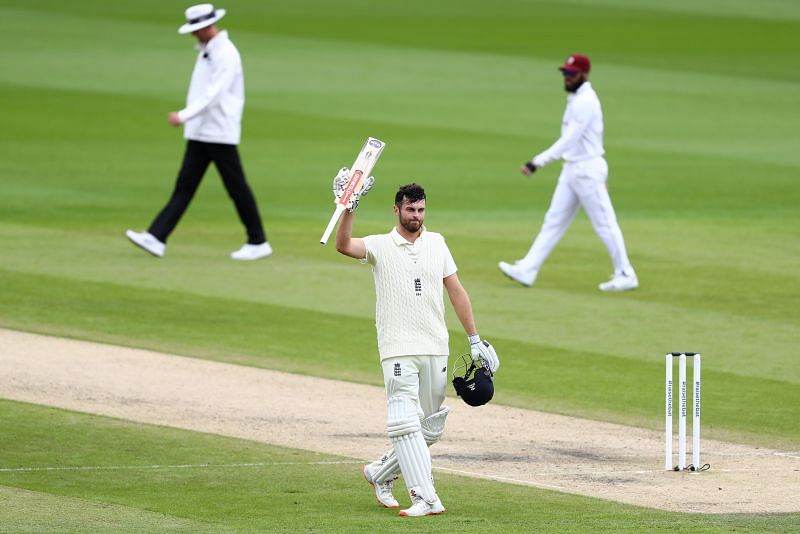
Dom Sibley's old-school technique faces novel Indian test
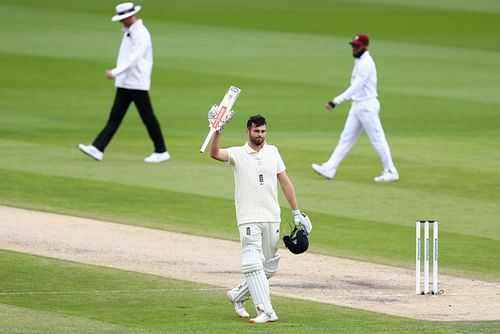
Back in November 2019, when Dom Sibley made his Test debut, England’s Test side was in utter turmoil. Though the Three Lions had escaped with a draw in the Ashes in the home summer, courtesy of one Ben Stokes, their winter began with a thumping against New Zealand at Mount Maunganui.
So when England traveled to South Africa, not much was expected of the side. Not only were they fielding several youngsters such as Sibley and Zak Crawley, but they also had to contend with a near-full strength Proteas outfit.
That England’s white-ball setup and culture were being blamed for the Three Lions’ incessantly toothless red-ball batting performances only highlighted their plight.
Akin to common cricketing logic, England suffered an annihilation in the 1st Test – a defeat that raised further questions over Joe Root’s captaincy and the sustainability of the players that they’d brought on board. However, they turned things around extraordinarily, ultimately triumphing 3-1 in the four-match series.
Sibley, who had come into the team on the back of a mountain of runs in domestic cricket, made his mark, courtesy of a sensational ton at Cape Town. Furthermore, Sibley notched up his maiden century in just his seventh innings, meaning that those who had been skeptical of his inclusion had suddenly jumped onto his bandwagon.
A few COVID-ridden months later, the opener solidified his position at the top of England’s order, courtesy of another gritty knock against the West Indies at Old Trafford. This time, he had Stokes for company. With Sibley’s propensity to patiently wait for scoring chances and Stokes’ proclivity to do the exact opposite, England ground the West Indians into submission.
International runs have dried up for Dom Sibley lately
Since then, runs have been at a premium for Sibley, although that hasn’t been for a lack of effort. In fact, the right-handed batter has tried to extract every ounce of performance from his system. Unfortunately, that hasn’t been enough in international cricket.
With a defining home summer against India beckoning, Sibley and his old-fashioned technique have to endure nervous looks over their shoulders. For a batter who portrayed as much determination as he did at Cape Town, this seems a bit of a paradox.
Over the years, Sibley has been a batter who has prioritized calculation over creativity. He rarely ventures out of his bunker and he only does so when he is sure that there is no danger of him being dismissed. In the process, he has played a lot of balls since his debut. The discrepancy, though, is that his run-scoring hasn’t grown proportionally.
Since Sibley’s debut, no English batter not named Joe Root has played more deliveries than the opener. If numbers are to be considered, it stands at 2794, with Sibley having accumulated those numbers across 35 innings.
Incredibly, the next best is Rory Burns, who has played 1848 balls in the same period. Stokes is a close fourth, with the all-rounder having played 1824 balls. Crawley, Jos Buttler and Ollie Pope, on the other hand, have played 1381, 1610 and 1313 balls respectively.
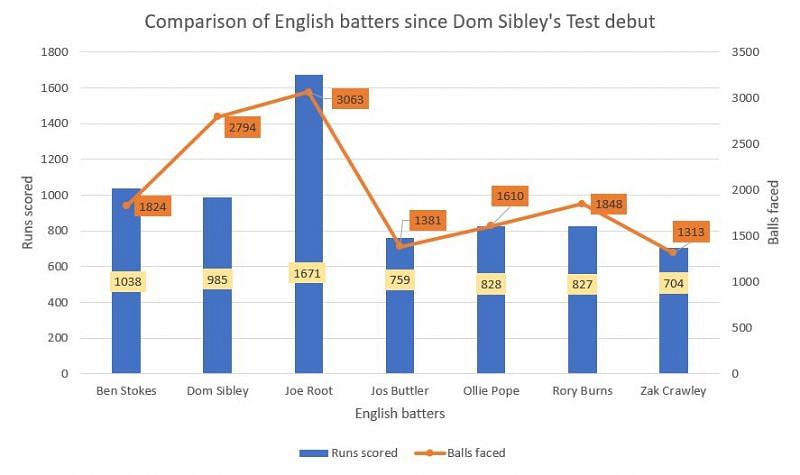
Thus, it seems pretty clear that Sibley is extremely adept at occupying the crease. The problem, then, is that he hasn’t regularly made those starts or long vigils count, meaning that the game hasn’t moved forward. To an extent, it might’ve even lulled England into a false sense of security, for when Sibley would’ve gotten dismissed, they would’ve lost a batter with the score not having changed a lot.
The numbers back up that argument too. While Sibley has the third-best tally of any English batter since his Test debut, he is miles away from Root (985 as opposed to the skipper’s 1671). Stokes is also ahead of him on this particular yardstick, having accumulated 1038 runs.
Though Sibley has better numbers than Burns, Buttler, Crawley and Pope, the bare fact remains that others on this list have just not played enough Test cricket. And lest one forgets, Sibley, since his debut, has played more Test innings than any other Englishman – the second-best is Root with 34 essays.
On the batting average front, a more damning picture is painted for Sibley. Despite having played the second-most balls since his debut in November 2020, his average is the second-worst among the aforementioned group.
To place things into further context, only Crawley, whose place is also under immense scrutiny, averages lower than Sibley during this period, hinting that Sibley might just be spending time at the crease without making the scoreboard tick.
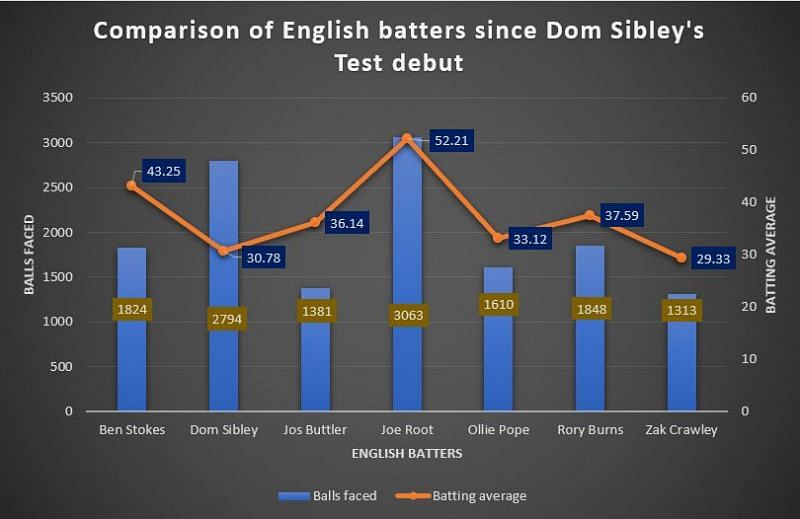
Prima facie, it might seem something that has no correlation to Sibley’s international run-scoring metric, considering this has been the way he has batted his entire career. He, unlike other firebrand white-ball specialists, was specifically called in to perform this kind of role.
Yet, there are plenty of other factors that have led to his recent slump – factors that indicate he is perhaps even skating on thin ice, as far as his international career is concerned.
Throughout the 2021 winter, England played a barrage of spin bowling against India and Sri Lanka. While they trumped the latter convincingly, they found the going a little tougher against the Men In Blue.
Sibley acclimatized himself extremely well during the 1st Test – a game where he scored 87 runs before being trapped LBW by Jasprit Bumrah. Post that, there was barely anything of note with Axar Patel making Sibley look like a cat on a hot tin roof.
In fact, the opener has a significant weakness against left-arm spin – something that could be exploited by Ravindra Jadeja, who is arguably the best left-arm spinner in the world. Against this particular style of bowling, Sibley averages 6.88, while his overall average against any kind of spin bowling is 19.42.
Additionally, against spinners, he seems to get stuck at the crease. He is not great at maneuvering the ball into gaps against the spin and often hopes for loose deliveries on the pads to aid his scoring endeavor. When confronting Ravichandran Ashwin and Jadeja, though, that might not be a luxury he would be afforded.
Interestingly, his boundary percentage is 44.87, which - considering his batting style - illustrates that run-scoring can become tedious and look cumbersome.
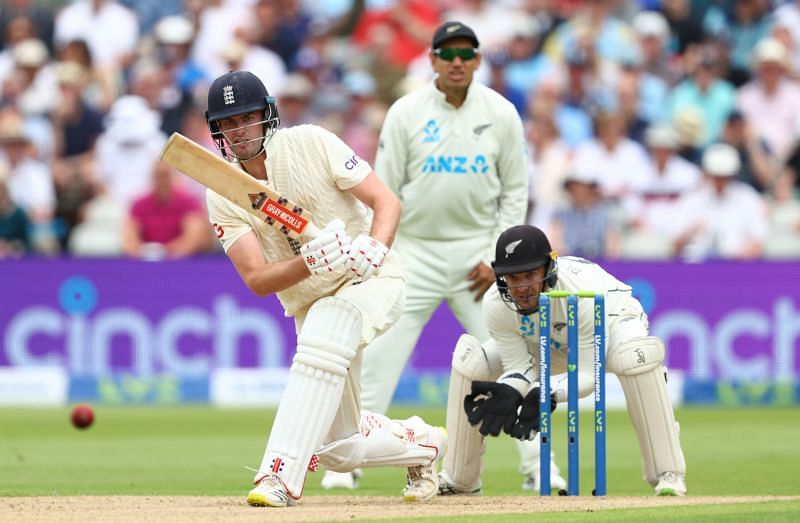
Apart from the above, he also has a tendency to fall over to the off side. While that hasn’t directly contributed to as many LBW dismissals (9 out of 32), it has made him susceptible to getting strangled down the leg side – a ploy the West Indies used in 2020 and one that India could also deploy, considering the success they enjoyed in Australia.
Having said that, there is still something unique about Sibley – something that forces England to put all their eggs in his basket. At his worst, Sibley looks archaic and out of sync. He even looks like someone who has made cricket as complicated as humanly possible.
At the peak of his powers, though, he can be a batter totally in control of himself - one who grinds down the bowlers and wears off the shine of the new ball. In blunter terms, he makes the job easier for his more illustrious contemporaries.
Moreover, he is one of the few batters to average more in the second innings (42.91 as opposed to 23.5) of a Test – a quality that is rare and needs to be cherished, considering matches are often decided in this phase.
Yet that is also arguably the trade-off England might have to finely gauge. If they are confident that Sibley can, more often than not, bring the best out of others around him, even if it is at the cost of his runs, they might not be wrong in entrusting him with responsibility at the top of the order.
Conversely, if his brand of batting, which is closer to the era of Test cricket sans T20s, puts undue run-scoring pressure on other batters, England might not really want Sibley opening the batting. Not just because it might set the wrong tempo but also because his returns have been ordinary, at best.
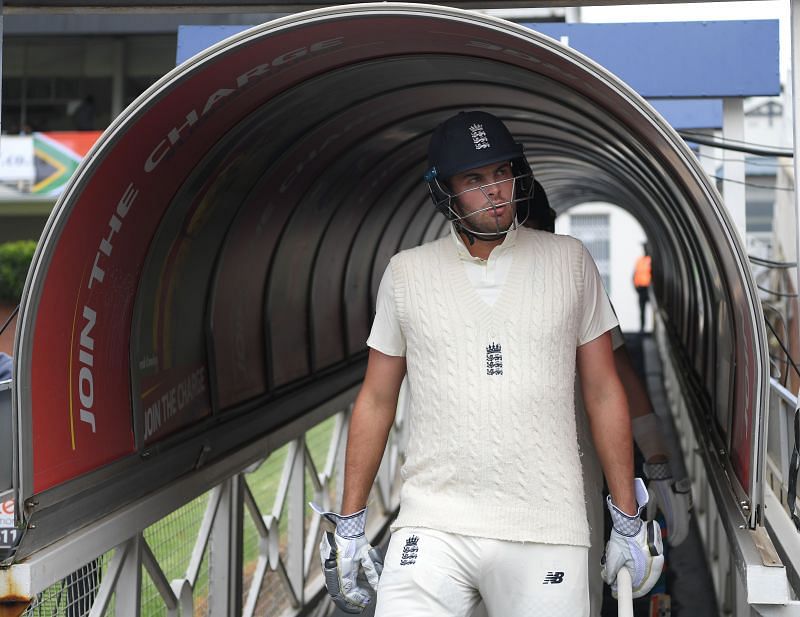
For now, though, England might just want to accord Sibley one final opportunity to stake his claim by batting the way he has done since picking up a cricket bat. And if historical data is an indicator, the opener comes out grafting and grinding when his back is against the wall.
As far as his old-school technique is concerned, well, it might not have faced as novel a test as the one India are going to throw at it. The upcoming series could not only define how Sibley’s career progresses but also shed further light on whether such relatively archaic batting styles still have a place in modern-day Test cricket.